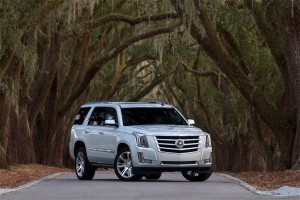
Large SUVs are gaining in popularity and one of the ways they become more "affordable" is to lease them.
It was a record sales year for U.S. automakers last year, a new high-water mark reached, in some measure because automotive lease volumes also hit a new benchmark of 4.3 million vehicles, according to a new study, which translates to more than 30% of all new vehicle sales.
Edmunds latest Lease Market Report noted that leasing accounted for 31% of all new vehicle sales in 2016, which is up from 29% in 2015 — the previous high. Overall, leasing has been on the rise for some time now – growing 91% in the last five years – as buyers look to get more bang for their buck.
That’s never been more true when it comes to a public hungry for all of the new sport-utilities, trucks and crossovers it can get its hands on. However, these vehicles often come with a heftier price tag than smaller sedans and coupe.
“Leasing has long been the gateway for car shoppers who are looking to get a nicer vehicle than they could if they financed,” said Jessica Caldwell, Edmunds executive director of industry analysis.
“Because SUVs and trucks are holding their values so well right now, it makes them much more accessible for a much wider swath of the market, further fueling their popularity.”
(Record sales year ahead for makers, analysts predict. Click Here for the story.)
For example, according to TrueCar.com, a loaded Chevrolet Suburban, costs about $67,000. To buy it, you would be looking at a down payment of $6,700 while you could lease it for around $2,000 down, with a monthly payment of about $100 less than a purchase.
Actually, Edmunds suggests the difference is larger with the average lease payment being$120 less than the average finance payment in 2016. For large SUVs, the average lease payment was $125 less, and for large pickup trucks the difference was $206, thanks in large part to high residual values.
Leases have another advantage: the length of the term. The average lease is three years long. However, to get that better equipped vehicle, buyers have been extending the term of their loans in recent years. The average loan term is now 69 months on average compared to 2011 when it was 64 months. The fastest growing loan term is the 72- to 84-month loan.
For a while, everyone worried if millennials would even buy cars and what’s happened is that millennials like leasing. While they accounted for just 12% of all vehicles leased last year, they lease in bigger numbers than other age groups.
(To see why analysts are predicting a dip in January auto sales, Click Here.)
“Leasing hits a sweet spot for millennials – they can enjoy the benefits of owning a new vehicle at a low price point with the latest features they crave,” Caldwell said.
“If automakers make a positive first impression with this influential group, they have a great opportunity to build lasting relationships as brand loyalty rates are much higher among shoppers who lease vs. buy.”
Luxury brands still capture the most lessees, but brands that have a heavy truck and SUV lineup are starting to play catch up. Brands like RAM, GMC and Chevrolet, who historically had lease penetration rates hovering between five and 12% five years ago, have seen lease rates jump more than 100%.
“While we think overall lease penetration will start to level off to 30% in 2017, the shift from passenger cars to trucks and SUVs shows no signs of slowing down,” Caldwell said.
(Click Here to see how Volkswagen moved past Toyota for the 2016 global auto sales crown.)
“As long as gas prices remain low and residual values on trucks and SUVs stay high, that segment of the lease market is likely to continue to expand this year.”


No one ever accused the millennials of being financially astute.